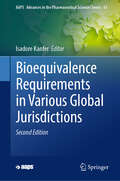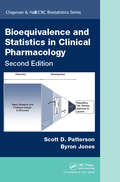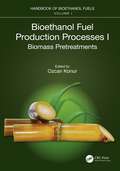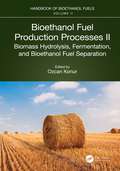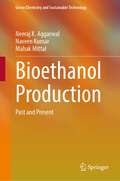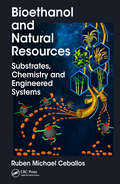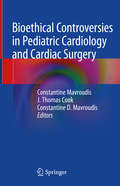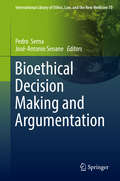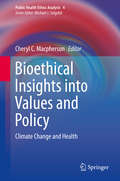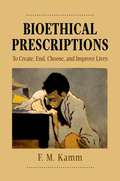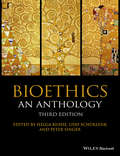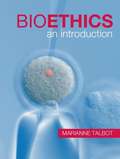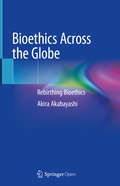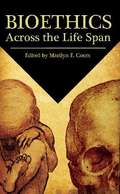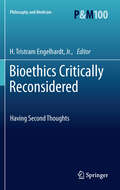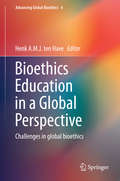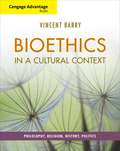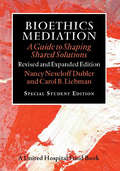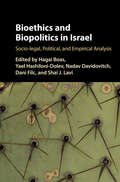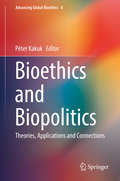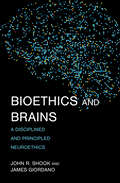- Table View
- List View
Bioequivalence Requirements in Various Global Jurisdictions (AAPS Advances in the Pharmaceutical Sciences Series #61)
by Isadore KanferAn important objective of Bioequivalence Requirements in Various Global Jurisdictions is to attempt to gather current and updated information, collated in a single source, regarding the various bioequivalence and related requirements to satisfy the regulatory requirements for the market approval of multi-source (generic) drug products in various global jurisdictions. In view of the dynamic nature of regulatory requirements which are usually regularly updated, updating these requirements to remain current is an important necessity to provide such information to drug manufacturers, regulatory agencies, pharmaceutical scientists and related health organizations and governments around the world in the quest to harmonize regulatory requirements for the market approval of generic products. The revised volume includes updated information based on recent guidances and guidelines from the respective regulatory agencies as well as important trends and descriptions relating to innovative approaches for bioequivalence assessment.
Bioequivalence and Statistics in Clinical Pharmacology (Chapman & Hall/CRC Biostatistics Series)
by Scott D. Patterson Byron JonesMaintaining a practical perspective, Bioequivalence and Statistics in Clinical Pharmacology, Second Edition explores statistics used in day-to-day clinical pharmacology work. The book is a starting point for those involved in such research and covers the methods needed to design, analyze, and interpret bioequivalence trials; explores when, how, and why these studies are performed as part of drug development; and demonstrates the methods using real world examples. Drawing on knowledge gained directly from working in the pharmaceutical industry, the authors set the stage by describing the general role of statistics. Once the foundation of clinical pharmacology drug development, regulatory applications, and the design and analysis of bioequivalence trials are established, including recent regulatory changes in design and analysis and in particular sample-size adaptation, they move on to related topics in clinical pharmacology involving the use of cross-over designs. These include, but are not limited to, safety studies in Phase I, dose-response trials, drug interaction trials, food-effect and combination trials, QTc and other pharmacodynamic equivalence trials, proof-of-concept trials, dose-proportionality trials, and vaccines trials. This second edition addresses several recent developments in the field, including new chapters on adaptive bioequivalence studies, scaled average bioequivalence testing, and vaccine trials. Purposefully designed to be instantly applicable, Bioequivalence and Statistics in Clinical Pharmacology, Second Edition provides examples of SAS and R code so that the analyses described can be immediately implemented. The authors have made extensive use of the proc mixed procedures available in SAS.
Bioethanol Fuel Production Processes. I: Biomass Pretreatments
by Ozcan KonurThis book presents research on biomass pretreatments, which are a fundamental part of bioethanol fuel production to make biomass more accessible. This book also includes an introductory section on the bioethanol fuels. Bioethanol Fuel Production Processes. I: Biomass Pretreatments is the first volume in the Handbook of Bioethanol Fuels (Six-Volume Set). The primary pretreatments at the macro level are the biological chemical, hydrothermal, and mechanical pretreatments of the biomass. It also has an introductory section on the biomass pretreatments at large for bioethanol fuel production. The major pretreatments at the micro level are the enzymatic and fungal pretreatments of the biomass as the biological pretreatments, acid, alkaline, ionic liquid, and organic solvent pretreatment pretreatments of the biomass as the chemical pretreatments, steam explosion and liquid hot water pretreatments of the biomass as the hydrothermal pretreatments, and milling, ultrasonic, and microwave pretreatments of the biomass as the mechanical pretreatments. The first volume also indicates that a wide range of pretreatments stand alone or in combination with each other fractionate the biomass to its constituents of cellulose, lignin, and hemicellulose and improve both sugar and bioethanol fuel yield, making this bioethanol fuel more competitive in relation to crude oil- and natural gas-based fossil fuels. This first volume is a valuable resource for the stakeholders primarily in the research fields of energy and fuels, chemical engineering, environmental science and engineering, biotechnology, microbiology, chemistry, physics, mechanical engineering, agricultural sciences, food science and engineering, materials science, biochemistry, genetics, molecular biology, plant sciences, water resources, economics, business, management, transportation science and technology, ecology, public, environmental and occupational health, social sciences, toxicology, multidisciplinary sciences, and humanities among others.
Bioethanol Fuel Production Processes. II: Biomass Hydrolysis, Fermentation, and Bioethanol Fuel Separation
by Ozcan KonurThis book provides an overview of the research on production processes for bioethanol fuels in general, hydrolysis of the pretreated biomass for bioethanol production, microbial fermentation of hydrolysates and substrates with yeasts for bioethanol production, and separation and distillation of bioethanol fuels from the fermentation broth, complementing the research on biomass pretreatments presented in the first volume. It presents an overview of the research on biomass hydrolysis in general, wood hydrolysis, straw hydrolysis, and cellulose hydrolysis for bioethanol fuel production in the first section for biomass hydrolysis. It provides an overview of the research on microbial hydrolysate fermentation for bioethanol production in general, alternative fermentation processes for bioethanol fuel production such as simultaneous saccharification and fermentation (SSF) and consolidated biomass processing (CBP) compared with the separate hydrolysis and fermentation (SHF) process, metabolic engineering of microorganisms and substrates for bioethanol fuel production, and utilization of Saccharomyces cerevisiae for microbial fermentation of hydrolysates for bioethanol fuel production in the second section for hydrolysate fermentation. It provides an overview of the research on the bioethanol fuel separation from the fermentation broth in the last section. This book is a valuable resource for the stakeholders primarily in the research fields of energy and fuels, chemical engineering, environmental science and engineering, biotechnology, microbiology, chemistry, physics, mechanical engineering, agricultural sciences, food science and engineering, materials science, biochemistry, genetics, molecular biology, plant sciences, water resources, economics, business, management, transportations science and technology, ecology, public, environmental and occupational health, social sciences, toxicology, multidisciplinary sciences, and humanities among others.
Bioethanol Production: Past and Present (Green Chemistry and Sustainable Technology)
by Naveen Kumar Neeraj K. Aggarwal Mahak MittalThis book provides the latest research on bioethanol production from first- and second- generation feedstock. Bioethanol has emerged as one of the main alternative biofuels in recent years. The book provides a perspective on the chemistry, sources and production of bioethanol highlighting the recent developments in the field.Through this book readers will learn basic and advanced bioethanol production technologies under one roof, including resource management and environmental and economic impacts. The topics discussed in the book will attract researchers and scholars focusing in this field as well as anyone who is interested in green and sustainable energy resources.
Bioethanol and Natural Resources: Substrates, Chemistry and Engineered Systems
by Ruben Michael CeballosBioethanol and Natural Resources: Substrates, Chemistry and Engineered Systems provides a comprehensive review of feedstocks, physiochemical and biological pretreatments, molecular substrates, cellulolytic and ligninolytic enzymes, and advanced technologies for producing bioethanol. Although this book provides a review of first-generation bioethanol feedstocks, chemistry, and processes, there is an emphasis on second-generation "cellulosic" ethanol production. With rapid advances in biofuels technologies and the continued global dependency on unsustainable extraction of fossil fuels, this text is timely. Although it is intended to be used as a supplemental text for advanced undergraduate or graduate level courses, the book is accessible to a non-academic audience. This book provides a unique opportunity to understand bioethanol production from the basic concepts and processes to the most cutting-edge technologies under development.
Bioethanol: A Green Energy Substitute for Fossil Fuels (Green Energy and Technology)
by Eriola Betiku Mofoluwake M. IsholaThis book looks deeply into the prospects for using ethanol as a greener alternative to fossil fuels and the technical and scientific issues that surround them. Ethanol, with its numerous advantages, has emerged as a promising contender to replace gasoline as a fuel source. Currently, it is commercially available as a blend with gasoline, commonly known as E10 and E25, utilizing various ratios of ethanol. Despite its clear benefits over gasoline, the widespread adoption of ethanol as a fuel remains hindered by its limited availability. In this insightful book, we aim to explore the multifaceted challenges surrounding ethanol's full integration into our energy landscape, employing a comprehensive approach through review manuscripts. Leading worldwide experts, known for their deep understanding of ethanol as a fuel, have contributed to the book. Their valuable insights and contributions enrich the book's content, offering readers a comprehensive exploration of the subject matter. This book is a compelling resource for researchers, energy professionals, and anyone interested in understanding the challenges and opportunities associated with the integration of ethanol as a substitute for gasoline.
Bioethical Controversies in Pediatric Cardiology and Cardiac Surgery
by Constantine Mavroudis J. Thomas Cook Constantine D. MavroudisThis title reviews the bioethical issues in congenital heart disease and other difficult pediatric cardiology and cardiac surgical situations. It provides considered opinions and recommendations as to the preferred actions to take in these cases, stressing the importance of making informed decisions that are bioethically sound and doing so using considered reasoning of all the related sensitive issues.Bioethical Controversies in Pediatric Cardiology and Cardiac Surgery provides detailed recommendations on potential solutions to make bioethical decisions in difficult clinical scenarios. There is particular emphasis on controversies involving surgery for hypoplastic left heart syndrome, futility, informed consent, autonomy, genomics, and beneficence. It is intended for use by a wide range of practitioners, including congenital heart surgeons, pediatric cardiologists, pediatric intensivists, nurse practitioners, physician’s assistants, and clinical ethicists.
Bioethical Decision Making and Argumentation (International Library of Ethics, Law, and the New Medicine #70)
by Pedro Serna José-Antonio SeoaneThis book clarifies the meaning of the most important and pervasive concepts and tools in bioethical argumentation (principles, values, dignity, rights, duties, deliberation, prudence) and assesses the methodological suitability of the main methods for clinical decision-making and argumentation. The first part of the book is devoted to the most developed or promising approaches regarding bioethical argumentation, namely those based on principles, values and human rights. The authors then continue to deal with the contributions and shortcomings of these approaches and suggest further developments by means of substantive and procedural elements and concepts from practical philosophy, normative systems theory, theory of action, human rights and legal argumentation. Furthermore, new models of biomedical and health care decision-making, which overcome the aforementioned criticism and stress the relevance of the argumentative responsibility, are included.
Bioethical Insights into Values and Policy: Climate Change and Health (Public Health Ethics Analysis #4)
by Cheryl C. MacphersonChanges in earth's atmosphere, oceans, soil, weather patterns, and ecosystems are well documented by countless scientific disciplines. These manifestations of climate change harm public health. Given their goals and social responsibilities, influential health organizations recognize health impacts compounded by geography, social values, social determinants of health, health behaviors, and relationships between humans and environments primarily described in feminist ethics and environmental ethics. Health impacts are relevant to, but seldom addressed in bioethics, global health, public policy, or health or environmental policy. This book is the first to describe cultural, geographic, and socioeconomic factors that influence the regional significance of these impacts and frame them for bioethics and policy analyses.
Bioethical Prescriptions: To Create, End, Choose, and Improve Lives
by F. M. KammBioethical Prescriptions collects F. M. Kamm's articles on bioethics, which have appeared over the last twenty-five years and which have made her among the most influential philosophers in this area. Kamm is known for her intricate, sophisticated, and painstaking philosophical analyses of moralproblems generally and of bioethical issues in particular. This volume showcases these articles - revised to eliminate redundancies - as parts of a coherent whole. A substantive introduction identifies important themes than run through the articles. Section headings include Death and Dying; Early Life (on conception and use of embryos, abortion, andchildhood); Genetics and Other Enhancements (on cloning and other genetic technologies); Allocating Scarce Resources; and Methodology (on the relation of moral theory and practical ethics).
Bioethics
by Peter Singer Udo Schüklenk Helga KuhseNow fully revised and updated, Bioethics: An Anthology, 3rd edition, contains a wealth of new material reflecting the latest developments. This definitive text brings together writings on an unparalleled range of key ethical issues, compellingly presented by internationally renowned scholars. The latest edition of this definitive one-volume collection, now updated to reflect the latest developments in the field Includes several new additions, including important historical readings and new contemporary material published since the release of the last edition in 2006 Thematically organized around an unparalleled range of issues, including discussion of the moral status of embryos and fetuses, new genetics, neuroethics, life and death, resource allocation, organ donations, public health, AIDS, human and animal experimentation, genetic screening, and issues facing nurses Subjects are clearly and captivatingly discussed by globally distinguished bioethicists A detailed index allows the reader to find terms and topics not listed in the titles of the essays themselves
Bioethics
by Marianne TalbotProviding readers with the confidence needed to debate key issues in bioethics, this introductory text clearly explains bioethical theories and their philosophical foundations. Over 250 activities introduce topics for personal reflection, and discussion points encourage students to think for themselves and build their own arguments. Highlighting the potential pitfalls for those new to bioethics, each chapter features boxes providing factual information and outlining the philosophical background, along with detailed case studies that offer an insight into real-life examples of bioethical problems. Within-chapter essay questions and quizzes, along with end-of-chapter review questions, allow students to check their understanding and to broaden their thinking about the topics discussed. The accompanying podcasts by the author (two of whose podcasts on iTunesU™ have attracted over 3 million downloads) explain points that might be difficult for beginners. These, along with a range of extra resources for students and instructors, are available at www. cambridge. org/bioethics.
Bioethics Across the Globe: Rebirthing Bioethics
by Akira AkabayashiThis open access book addresses a variety of issues relating to bioethics, in order to initiate cross-cultural dialogue. Beginning with the history, it introduces various views on bioethics, based on specific experiences from Japan. It describes how Japan has been confronted with Western bioethics and the ethical issues new to this modern age, and how it has found its foothold as it decides where it stands on these issues. In the last chapter, the author proposes discarding the overarching term ‘Global Bioethics’ in favor of the new term, ‘Bioethics Across the Globe (BAG)’, which carries a more universal connotation. This book serves as an excellent tool to help readers understand a different culture and to initiate deep and genuine global dialogue that incorporates local and global thinking on bioethics. Bioethics Across the Globe is a valuable resource for researchers in the field of bioethics/medical ethics interested in adopting cross-cultural approaches, as well as graduate and undergraduate students of healthcare and philosophy.
Bioethics Across the Life Span
by Marilyn E. Coors National Catholic Bioethics Center StaffWritten for a lay audience, this volume contains essays on general bioethics, reproductive technologies, rape protocols, vaccines, organ transplantation, stem cells, genetic counseling, genetic engineering, and critical end-of-life issues. The authors are leading Catholic bioethicists Erica Laethem, John Haas, Edward Furton, Marilyn Coors, and Archbishop José Gomez. Suitable for classroom use. Includes an easy-reference glossary.
Bioethics Beyond Altruism: Donating and Transforming Human Biological Materials
by Rhonda M ShawThis book departs from conventional bioethics approaches to consider the different moral and political economies involved in the donation and transformation of human organs, gametes, stem cells and breastmilk. Collectively, the authors draw attention to the different values associated with research and therapy on body part and tissue exchange through an examination of altruism, gift and commodity relations. They expertly discuss issues such as the bioethical conundrums around the circulation and use of human biological materials and services as well as their legal and regulatory limits, the economic benefits and health values attributed to various body parts and products, and the matter of immaterial labour and affective relations between donors, recipients and others involved in tissue provision.Based on new empirical research, this interdisciplinary collection of original and timely essays will be of interest to students and researchers in gender and cultural studies, sociology, anthropology, science and technology studies, as well as medical professionals with an interest in health and reproduction.
Bioethics Critically Reconsidered: Having Second Thoughts (Philosophy and Medicine #100)
by H. Tristram EngelhardtBioethics developed as an academic and clinical discipline during the later part of the 20th century due to a variety of factors. Crucial to this development was the increased secularization of American culture as well as the dissolution of medicine as a quasi-guild with its own professional ethics. In the context of this moral vacuum, bioethics came into existence. Its raison d'être was opposition to the alleged paternalism of the medical community and traditional moral frameworks, yet at the same time it set itself up as a source of moral authority with respect to biomedical decision making. Bioethics serves as biopolitics in so far as it attempts to make determinations about how individuals ought to make medical decisions and then attempts to codify that in law. Progressivism and secularism are ultimately the ideology of bioethics.
Bioethics Education in a Global Perspective: Challenges in global bioethics (Advancing Global Bioethics #4)
by Henk A.M.J. ten HaveThis book critically analyses experiences with bioethics education in various countries across the world and identifies common challenges and interests. It presents ethics teaching experiences in nine different countries and the basic question of the goals of bioethics education. It addresses bioethics education in resource-poor countries, as the conditions and facilities are widely different and set limits and provide challenges to bioethics educators. Further, the question of how bioethics education can be improved is explored by the contributors. Despite the volume of journal publications agreement on bioethics education is rather limited. There are only few examples of core curricula, demonstrating consensus on the contents, goals, methods and assessment of teaching programs. We need ask: How can agreement on the best modalities of bioethics education be promoted?.
Bioethics In A Cultural Context: Philosophy, Religion, History, Politics
by Vincent BarryBIOETHICS IN A CULTURAL CONTEXT--PHILOSOPHY, RELIGION, HISTORY, POLITICS presents a unique, philosophical approach to modern bioethics. Rather than simply setting up debates about contemporary issues, this book helps students understand that many of today's bioethical controversies are tied to profound underlying questions fundamental as: When does life begin and end? What is a human being or person? What is life's purpose? What is the ideal society? The text is comprehensive and accessible, featuring a wide range of content that is crisply presented and clearly explained. A multitude of interesting examples and cases provides ample opportunity for discussion, debate, and research.
Bioethics Mediation: A Guide to Shaping Shared Solutions
by Nancy Dubler Carol LiebmanProvides the conceptual framework supporting the need for mediation in the medical context
Bioethics Mediation: A Guide to Shaping Shared Solutions, Revised and Expanded Edition
by Nancy Neveloff Dubler Carol B. LiebmanExpanded by two-thirds from the 2004 edition, the new edition features two new role plays, a new chapter on how to write chart notes, and a discussion of new understandings of the role of the clinical ethics consultant. **** Bioethics Mediation offers stories about patients, families, and health care providers enmeshed in conflict as they wrestle with decisions about life and death. It provides guidance for those charged with supporting the patient’s traditional and religious commitments and personal wishes. Today’s medical system, without intervention, privileges those within shared cultures of communication and disadvantages those lacking power and position, such as immigrants, the poor, and nonprofessionals. This book gives clinical ethics consultants, palliative care providers, and physicians, nurses, and other medical staff the tools they need to understand and manage conflict while respecting the values of patients and family members. Conflicts come in different guises, and the key to successful resolution is early identification and intervention. Every bioethics mediator needs to be prepared with skills to listen, “level the playing field,” identify individual interests, explore options, and help craft a “principled resolution”—a consensus that identifies a plan aligned with accepted ethical principles, legal stipulations, and moral rules and that charts a clear course of future intervention. The organization of the book makes it ideal for teaching or as a handbook for the practitioner. It includes actual cases, modified to protect the privacy of patients, providers, and institutions; detailed case analyses; tools for step-by-step mediation; techniques for the mediator; sample chart notes; and a set of actual role plays with expert mediator and bioethics commentaries. The role plays include: • discharge planning for a dying patient • an at-risk pregnancy • HIV and postsurgical complications in the ICU • treatment for a dying adolescent • dialysis and multiple systems failure
Bioethics Mediation: A Guide to Shaping Shared Solutions, Revised and Expanded Edition
by Nancy Neveloff Dubler Carol B. LiebmanBioethics Mediation offers stories about patients, families, and health care providers enmeshed in conflict as they wrestle with decisions about life and death. It provides guidance for those charged with supporting the patient's traditional and religious commitments and personal wishes. Today's medical system, without intervention, privileges those within shared cultures of communication and disadvantages those lacking power and position, such as immigrants, the poor, and nonprofessionals. This book gives clinical ethics consultants, palliative care providers, and physicians, nurses, and other medical staff the tools they need to understand and manage conflict while respecting the values of patients and family members. Conflicts come in different guises, and the key to successful resolution is early identification and intervention. Every bioethics mediator needs to be prepared with skills to listen, "level the playing field," identify individual interests, explore options, and help craft a "principled resolution" -- a consensus that identifies a plan aligned with accepted ethical principles, legal stipulations, and moral rules and that charts a clear course of future intervention. The organization of the book makes it ideal for teaching or as a handbook for the practitioner. It includes actual cases, modified to protect the privacy of patients, providers, and institutions; detailed case analyses; tools for step-by-step mediation; techniques for the mediator; sample chart notes; and a set of actual role plays with expert mediator and bioethics commentaries. The role plays include: - discharge planning for a dying patient - an at-risk pregnancy - HIV and postsurgical complications in the ICU - treatment for a dying adolescent - dialysis and multiple systems failure Expanded by two-thirds from the 2004 edition, the new edition features two new role plays, a new chapter on how to write chart notes, and a discussion of new understandings of the role of the clinical ethics consultant.
Bioethics and Biopolitics in Israel: Socio-legal, Political, and Empirical Analysis
by Shai J. Lavi Hagai Boas Hashiloni-Dolev Yael Nadav Davidovitch Dani FilcAlthough the 'Israeli case' of bioethics has been well documented, this book offers a novel understanding of Israeli bioethics that is a milestone in the comparative literature of bioethics. Bringing together a range of experts, the book's interdisciplinary structure employs a contemporary, sociopolitical-oriented approach to bioethics issues, with an emphasis on empirical analysis, that will appeal not only to scholars of bioethics, but also to students of law, medicine, humanities, and social sciences around the world. Its focus on the development of bioethics in Israel makes it especially relevant to scholars of Israeli society - both in and out of Israel - as well as medical practitioners and health policymakers in Israel.
Bioethics and Biopolitics: Theories, Applications and Connections (Advancing Global Bioethics #8)
by Péter KakukThis volume links three different theoretical approaches that have a common focus on the relationship between biopolitics and bioethics. This collection of papers can be categorized into different domains that are representative of the contemporary usage of biopolitics as a concept. On the one hand, several chapters develop a clear and up-to-date understanding of the primary sources of the concept and related theories of Agamben, Negri or Foucault and approach the question of relevance within the field of bioethics. Another group of papers apply the philosophical concepts and theories of biopolitics (biopower, Homo Sacer, biocitizenship) on very specific currently debated bioethical issues. Some scholars rely on the more mundane understanding of (bio)politics and investigate how its relationship with bioethics could be philosophically conceptualized. Additionally, this work also contains papers that follow a more legally oriented analysis on the effects of contemporary biopolitics on human rights and European law. The authors are philosophers, legal scholars or bioethicists. The major strength of this volume is to provide the reader with major insights and orientation in these different contemporary usages of the concept and theories of biopolitics, within the context of its various ethically relevant applications.
Bioethics and Brains: A Disciplined and Principled Neuroethics (Basic Bioethics)
by John R. Shook James GiordanoHow neuroethics can be increasingly relevant and informative for inclusive social policy and political discourse about brain science and technologies.Neuroethics, a field just over two decades old, addresses both ethical issues generated in and by brain sciences and the neuroscientific studies of moral and ethical thought and action. These foci are reciprocally interactive and prompt questions of how science and ethics can and should harmonize. In Bioethics and Brains, John R. Shook and James Giordano ask: How can the brain sciences inform ethics? And how might ethics guide the brain sciences and their real-world applications?The authors&’ structure for a disciplined neuroethics reconciles science and ethics by requiring ethical principles consistent with moral neuroscience and moral psychology. Their cosmopolitan perspective looks beyond Western theories toward a new metaethics for neuroethics and illustrates its approach in chapters that address the issues and approaches to questions and problems generated by the proliferation of neurotechnology in global contexts. Shook and Giordano posit that neuroethics can merge science and ethics toward establishing global consensus on guiding brain research, neurotechnological innovation, and grounding neurorights.
